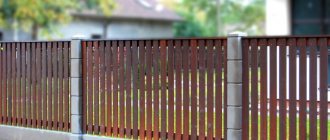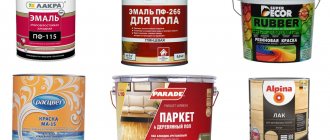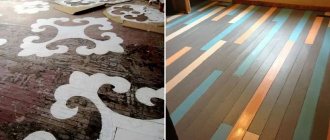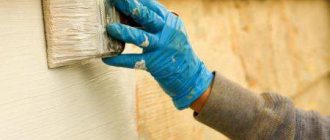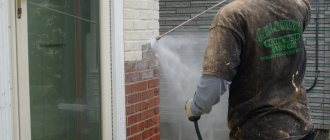Wood has been considered one of the main building materials for a long time. Wood was used both to build houses and to construct surrounding infrastructure (fences, sheds, poles, etc.). But how to treat a wooden fence if it is so exposed to environmental hazards?
With the development of technology, new building materials have appeared, which have supplanted the position of wooden structures in house construction. But wood is still on the list of the most popular materials for construction work in the private sector. This is especially true for the construction of various fences and fencing.
Why and from what it is necessary to protect natural wood
Wood is 90-99% organic. This makes it vulnerable to environmental influences:
- high humidity. Unprotected wood, like a sponge, absorbs excess moisture from the air during precipitation and dew. As a result, mold multiplies in it, and pockets of rot appear;
- atmospheric phenomena. A wooden fence is constantly exposed to the open sky and is susceptible to the influence of sun, wind, rain, and frost. All these factors lead to mechanical destruction of wood fibers, causing the formation of cracks;
- exposure to fire. This material is flammable, it can easily ignite from any spark;
- biological factors. Many insects feed on wood (bark beetles, borers). They make internal passages in it, which spoils the appearance of the product and reduces its performance.
Bottom line: therefore, wood requires protection from moisture, fire, insects, and the destructive effects of the external environment.
Swedish paint
Copper sulfate included in the coating for a wooden fence
To prepare the coating, combine 3 liters of water and 600 g of rye flour and place on fire. Stir continuously to avoid lumps. After obtaining a homogeneous mass, add salt and copper sulfate - 250 g each. When the crystals are completely dissolved, add 250g of red lead and mix well. At the end, add 250g of drying oil, mix again, and pour another 1.5 liters of water.
Use the prepared paint immediately, without allowing it to cool. As it cools, it thickens, and then you have to dilute it with water. This is undesirable, since the thinned paint layer will be less thin and durable. Swedish paint comes in red, brown or yellow. You can paint the fence with it once.
What tools to use
To protect wooden structures, special means are used - antiseptics, protective impregnations. They are presented as:
- paste;
- organic compounds;
- aqueous solutions;
- oil emulsions.
Recommendation: Since the fence is constantly exposed to the open air, weatherproof exterior products should be used before protecting it.
You can make your own impregnation for a wooden fence. For this purpose, means are used that create an unfavorable environment for the development and reproduction of bacteria. It could be copper/iron sulfate. The substance is diluted in water and the wood is soaked in this bath for a day.
Natural raw materials will be protected from rotting by treating them with hot oil. You can also use tar and turpentine for these purposes.
The Finns, who specialize in wood processing, have come up with their own method of protecting it. To do this, they use a mixture of flour, vitriol, lime and salt. All this should be diluted with hot water and the wood should be soaked in the composition twice. You can add color to the liquid to give the material a certain shade. This Finnish impregnation ensures the safety of raw materials for up to 20 years.
Of the ready-made compositions for protecting wood, liquid glassine, consisting of herbicides and antiseptics, is effective. It is suitable for use in conditions of high humidity - it can be applied even in rainy, damp weather to fresh wood. Due to its light structure, the solution quickly penetrates deep into the material, displacing water from it. There it polymerizes, closing all microcracks and pores. This provides protection from insects, water, air, and microorganisms.
Cement-based composition
To make a protective mixture for a wooden fence you will need cement.
Cement mixture is a cheap and high-quality material for wooden surfaces. It allows the wood to breathe, but does not protect well from moisture. The problem can be solved with the help of special additives. The cement composition is not in the direct sense of paint, however, the coating made from it is very effective.
To make it, you need to mix high-quality cement with water until the thickness of village milk, then add the selected dye. You will find it in the store. If you decide to use improvised material, then you need to do this carefully. Clay and cement can reduce the hardness of the coating. The ideal option would be to use grated brick.
The strength of the coating with this composition is explained by a special chemical reaction. The lime seems to be welded to the wood. This composition hardens quickly and therefore it is necessary to prepare small portions. They are used immediately. The problem can only be in the uniform color of the surface being painted.
Features of fence processing
When applying protective compounds to fence elements, a number of factors should be taken into account. The side facing the street must be coated with an antiseptic that will not spoil the appearance of the wood. On the back side of the fence it is not necessary to adhere to this rule.
It is also necessary to take into account that the fencing parts are in different conditions: some have constant contact with the ground (pillars), while others take the main “impacts” of the environment (sections). The location of the fence also matters. If it is located on the sunny side, it is necessary to provide it with additional protection from fading.
Advice: given these factors, it is better to purchase several antiseptics for different purposes and compositions.
Finnish paint
Iron ocher for making a Finnish mixture for painting wooden fences
During manufacturing, it is very important to strictly observe all proportions and technology. Take 6 liters of water, add 720 g of rye flour there and mix well. Then the mixture needs to be strained, put on fire and, stirring, add 360g of table salt. Iron sulfate and dry lime pigment are also added to the solution - 1560 g of each. Boil another 3 liters of water and pour into the resulting mixture.
The boards are painted with this composition twice, preferably on clean wood. If it was previously painted, the old paint must be removed. Finnish paint is breathable and durable. To give it an unusual color, you can add grated brick, decoctions of oak bark or sunflower seeds.
Protecting a new fence
After purchasing wood for building a fence, you can immediately begin processing it. It is performed in the following sequence:
- Posts, veins and boards for fence sections are cleared of bark.
- The material can be planed to close the pores. This will extend the life of the raw materials.
- If there is contamination or a rough surface, these areas are treated with sandpaper.
- Small potholes and cracks are filled with a special primer that smoothes the surface of the wood. After this, these areas are sanded again.
- All parts are coated with a protective agent. Depending on the consistency, it is applied with a brush or by dipping.
- A day later, when the wood has absorbed the substance, the procedure is repeated.
- After all elements have completely dried, installation of the fence begins.
Note: impregnation against rotting and insects will not only protect the wood, but also reduce paint consumption.
Preparing for painting
If the owner decides to paint the wooden fence, then after completing the procedure with an antiseptic, a primer layer is applied to it. It will ensure strength, long service life of the paint, and protect the wood from rotting. After drying, the primer is applied again. It is irrational to cover wood with thick colored paint. The tree loses its natural attractiveness.
Therefore, it is recommended to treat wooden fences with impregnation, stain or varnish. The natural pattern remains visible and is preserved for the entire life of the fence.
Building materials stores have a large selection of varnish materials: acrylic, alkyd, polyurethane, dispersion. Any of them is suitable for covering the surface of wood, but the most environmentally friendly is acrylic-based varnish. It does not cover the wood grain, but rather emphasizes its elegance.
Return to contents
Processing an old fence
Protection is needed not only for a new fence, but also for an old fence that has served for several years. The first step is to inspect the structure. It is removed from the old coating, dirt, and mold. Parts with rotten areas are replaced.
Remember: antiseptics and impregnations do not restore wood, they only protect it. The smoother the base, the better the primer and paint will adhere.
Impregnation is applied to the cleaned, leveled surface in two layers, allowing each layer to dry for at least a day. The product will close the pores of the material and prevent its further destruction. Distribute the special composition with a brush, after stirring well.
You can read how to build yourself a fence from pallets here...
Preparing lumber for the fence
In accordance with the above, it is necessary to follow the following recommendations before starting work on installing the fence:
- It is necessary to purchase high-quality wood, without rot and wormholes - passages left by the larvae of wood-boring insects or bark beetles.
- If possible, it is better to buy pre-dried wood, otherwise you need to dry it yourself by stacking it. There are five basic rules for its installation:
- Wood should not be laid directly on the ground to dry. It is necessary to lay supports made of bricks, logs, timber, etc. under the bottom row.
- In the rows between the boards, a gap (vent) of 2-3 cm wide is required.
- Layers of lumber are laid with spacers - cuttings of boards, placing them with slats in increments of 1-1.5 meters.
- The stack must be covered on top with some kind of moisture-proofing material without covering the sides.
- The ends of the boards are coated with oil-based paint or used machine oil.
The drying time of lumber in a stack depends on the thickness of the latter and can range from several weeks to a couple of months, so it must be purchased in advance.
Fire protection
If the fence is located next to buildings on the site, it can be provided with additional protection from fire. To do this, the raw materials should be coated with a fire retardant with an antiseptic effect. This product penetrates deep into the material, creating a protective film on its surface. Fire retardants are applied by soaking the raw material in a bath or using a brush/spray.
Attention: when working with ready-made or home-made wood protective compounds, you must follow safety precautions (wear a respirator, gloves).
Treating a wooden fence will allow you to take care of its durability even at the construction stage. A high-quality composition applied using appropriate technology will protect the material for a long time from the destructive influence of the environment, preserving its natural structure and beauty.
Why do you need to paint a wooden fence?
A board fence can decorate any garden area, but wood is not resistant to various weather conditions. Painting a wooden fence is necessary to increase its service life.
If the tree is left without additional coating, then after a year its appearance will change. And after a couple of years, under the influence of precipitation, the material will begin to rot.
In addition to rain and snow, wood can be damaged by bark beetles, mold and moss. Only coating with a protective layer will increase the service life of the fence.
